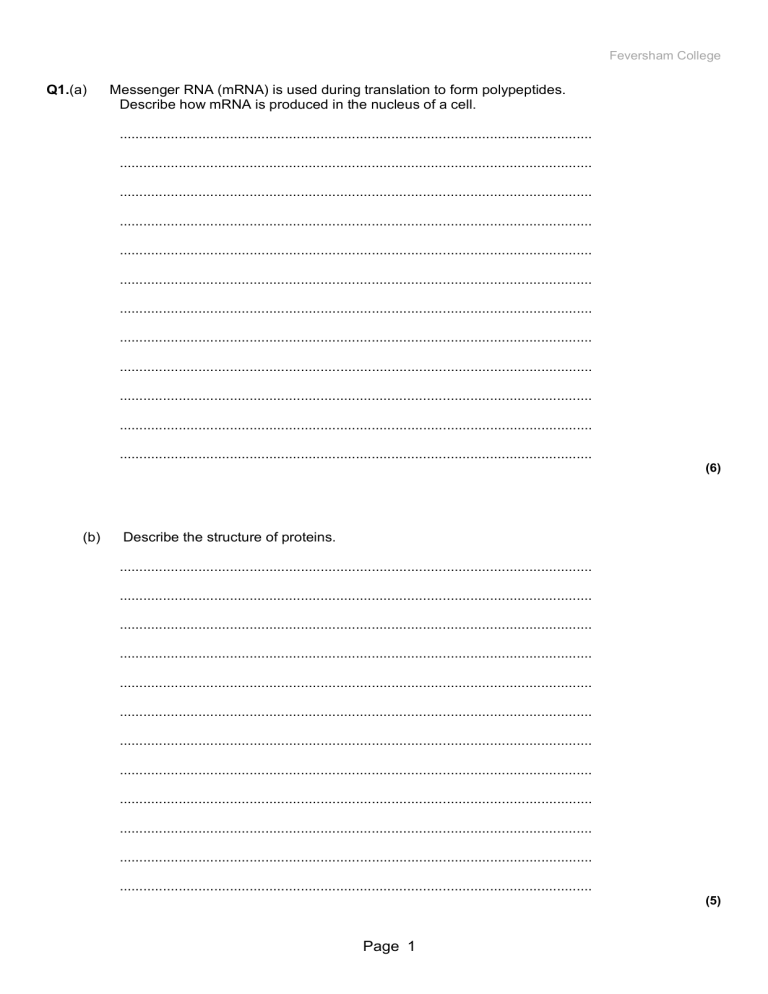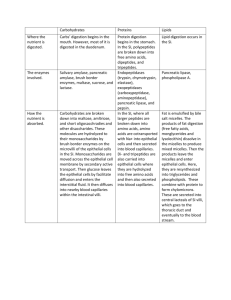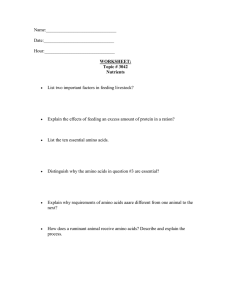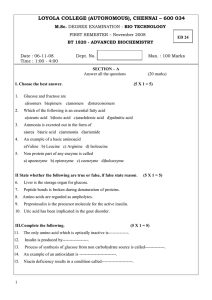
Feversham College Q1.(a) Messenger RNA (mRNA) is used during translation to form polypeptides. Describe how mRNA is produced in the nucleus of a cell. ........................................................................................................................ ........................................................................................................................ ........................................................................................................................ ........................................................................................................................ ........................................................................................................................ ........................................................................................................................ ........................................................................................................................ ........................................................................................................................ ........................................................................................................................ ........................................................................................................................ ........................................................................................................................ ........................................................................................................................ (6) (b) Describe the structure of proteins. ........................................................................................................................ ........................................................................................................................ ........................................................................................................................ ........................................................................................................................ ........................................................................................................................ ........................................................................................................................ ........................................................................................................................ ........................................................................................................................ ........................................................................................................................ ........................................................................................................................ ........................................................................................................................ ........................................................................................................................ (5) Page 1 Feversham College (c) Describe how proteins are digested in the human gut. ........................................................................................................................ ........................................................................................................................ ........................................................................................................................ ........................................................................................................................ ........................................................................................................................ ........................................................................................................................ ........................................................................................................................ ........................................................................................................................ ........................................................................................................................ ........................................................................................................................ ........................................................................................................................ ........................................................................................................................ (4) (Total 15 marks) Q2. S The figure below shows the processes involved in absorbing amino acids into a capillary from the small intestine. Page 2 Feversham College (i) Name processes A, B and C. In each case, give the evidence for your answer. A Process ............................................................................................... Evidence ............................................................................................. ............................................................................................................ B Process .............................................................................................. Evidence ............................................................................................. ............................................................................................................ C Process .............................................................................................. Evidence ............................................................................................. ............................................................................................................. (3) (ii) Explain how process B creates the conditions for process A to occur. ...................................................................................................................... ...................................................................................................................... ...................................................................................................................... ...................................................................................................................... (2) (Total 5 marks) Page 3 Feversham College Q3. The diagram shows one method by which amino acids are absorbed from the small intestine into the blood. They are co-transported into the epithelial cell with sodium ions (Na +) at point X on the diagram. Normally, the concentration of sodium ions inside the epithelial cell is low. Source: adapted from M. ROWLAND, Biology (University of Bath Science 16-19) (Nelson Thornes) 1992. Dinitrophenol (DNP) prevents oxidative phosphorylation. When treated with DNP, the sodiumpotassium pump at Y no longer works. As a result, the concentration of sodium ions in the cell rises and amino acid absorption stops. (i) Explain why pump Y will not work in the presence of DNP. ...................................................................................................................... ...................................................................................................................... ...................................................................................................................... ...................................................................................................................... (2) Page 4 Feversham College (ii) Explain why sodium ions and amino acids are not absorbed from the lumen of the small intestine in the presence of DNP. ...................................................................................................................... ...................................................................................................................... ...................................................................................................................... ...................................................................................................................... (2) (iii) By what mechanism would amino acids leave the epithelial cell at point Z? ...................................................................................................................... (1) (Total 5 marks) Q4.(a) Describe the role of the enzymes of the digestive system in the complete breakdown of starch. ...................................................................................................................... ...................................................................................................................... ...................................................................................................................... ...................................................................................................................... ...................................................................................................................... ...................................................................................................................... ...................................................................................................................... ...................................................................................................................... ...................................................................................................................... ...................................................................................................................... (5) (b) Describe the processes involved in the absorption of the products of starch digestion. ...................................................................................................................... ...................................................................................................................... ...................................................................................................................... ...................................................................................................................... ...................................................................................................................... ...................................................................................................................... ...................................................................................................................... Page 5 Feversham College ...................................................................................................................... ...................................................................................................................... ...................................................................................................................... (5) (Total 10 marks) Q5. Different cells in the body have different functions. (a) Some white blood cells are phagocytic. Describe how these phagocytic white blood cells destroy bacteria. ...................................................................................................................... ...................................................................................................................... ...................................................................................................................... ...................................................................................................................... ...................................................................................................................... ...................................................................................................................... ...................................................................................................................... ...................................................................................................................... (Extra space) ............................................................................................... ..................................................................................................................... ..................................................................................................................... ..................................................................................................................... ..................................................................................................................... (4) (b) The epithelial cells that line the small intestine are adapted for the absorption of glucose. Explain how. ..................................................................................................................... ..................................................................................................................... ..................................................................................................................... ..................................................................................................................... ..................................................................................................................... ..................................................................................................................... ..................................................................................................................... ..................................................................................................................... Page 6 Feversham College ..................................................................................................................... ..................................................................................................................... ..................................................................................................................... ..................................................................................................................... (Extra space) ............................................................................................... ..................................................................................................................... ..................................................................................................................... ..................................................................................................................... ..................................................................................................................... (6) (Total 10 marks) Q6. (a) Dietary recommendations are that lipid intake should make up 30% of energy intake. The recommended energy intake for most women aged 19-49 is 8100 kJ day–1.The energy content of lipid is 37.8 kJ g–1. Calculate the recommended lipid intake per day for these women. Show your working. Answer ................................................... g (2) In humans, triglycerides are the main form of dietary lipids. They are digested in the gut and the products of digestion are absorbed by the small intestine. S (b) Describe a biochemical test that could be performed on a sample of food to determine whether it contained triglycerides. ...................................................................................................................... ...................................................................................................................... ...................................................................................................................... ...................................................................................................................... (2) (c) The diagram shows the events that occur in the absorption of monoglycerides and fatty acids. These molecules enter the epithelial cells of the small intestine by diffusion. Once inside they are reassembled into triglycerides in organelle Q. The triglyceride molecules are formed into chylomicrons in organelle T. Chylomicrons are made from many triglyceride molecules surrounded with protein molecules. The chylomicrons leave the cell and enter vessel S. Page 7 Feversham College S (i) Explain the importance of the structures labelled P. ............................................................................................................. ............................................................................................................. (1) (ii) Name R; ....................................................................................................... S. ........................................................................................................ (2) S (iii) Describe the role played by organelle U in the formation of chylomicrons. ............................................................................................................. ............................................................................................................. ............................................................................................................. ............................................................................................................. (2) S (iv) Suggest how the chylomicrons leave the epithelial cell. Give a reason for your answer. ............................................................................................................. ............................................................................................................. ............................................................................................................. ............................................................................................................. (2) (Total 11 marks) Page 8 Feversham College Page 9 Feversham College M1.(a) 1. 2. 3. 4. 5. 6. 7. Helicase; Breaks hydrogen bonds; Only one DNA strand acts as template; RNA nucleotides attracted to exposed bases; (Attraction) according to base pairing rule; RNA polymerase joins (RNA) nucleotides together; Pre-mRNA spliced to remove introns. 6 max (b) 1. 2. 3. 4. 5. Polymer of amino acids; Joined by peptide bonds; Formed by condensation; Primary structure is order of amino acids; Secondary structure is folding of polypeptide chain due to hydrogen bonding; Accept alpha helix / pleated sheet 6. Tertiary structure is 3-D folding due to hydrogen bonding and ionic / disulfide bonds; Quaternary structure is two or more polypeptide chains. 7. 5 max (c) 1. 2. 3. 4. Hydrolysis of peptide bonds; Endopeptidases break polypeptides into smaller peptide chains; Exopeptidases remove terminal amino acids; Dipeptidases hydrolyse / break down dipeptides into amino acids. 4 [15] M2. (i) In all cases reject ‘energy’ unless qualified A – facilitated diffusion as transport protein needed but ATP not needed; B – active transport ‘energy’ unless as (transport protein and) ATP needed; qualified C – (simple) diffusion as neither ATP nor transport protein needed; (Ignore all references to concentration gradients) 3 (ii) creates low concentration of amino acids / Na+ in cell concentration gradient established between lumen and cell (of amino acids or Na+) 2 [5] Page 10 Feversham College M3. (i) Lack of ATP; Pump = active transport / requires energy / ATP provides energy / transport is up concentration gradient; 2 (ii) Concentration of Na+ inside cell no longer less than concentration in gut lumen / no longer a concentration gradient; No (facilitated) diffusion of NA+ ions possible / amino acid absorption requires diffusion of Na+ ions into cell; 2 (iii) Diffusion / facilitated diffusion; 1 [5] M4.(a) Amylase; (Starch) to maltose: Maltase; Maltose to glucose; Hydrolysis; (Of) glycosidic bond; Q Do not penalise incorrect site for digestion or incorrect site of enzyme production. 5 max (b) Glucose moves in with sodium (into epithelial cell); Via (carrier / channel) protein / symport; Sodium removed (from epithelial cell) by active transport / sodium- potassium pump; Into blood; Maintaining low concentration of sodium (in epithelial cell) / maintaining sodium concentration gradient (between lumen and epithelial cell); Glucose moves into blood; By (facilitated) diffusion; Q Only allow diffusion mark in context of movement of glucose into the blood. 5 max [10] Page 11 Feversham College M5. (a) 1. Phagocyte attracted to bacteria by chemicals / recognise antigens on bacteria as foreign; 2. Engulf / ingest bacteria; 3. Bacteria in vacuole / vesicle; 4. Lysosome fuses with / empties enzymes into vacuole; 5. Bacteria digested / hydrolysed; 1. Accept names chemical e.g. toxin 2. Allow description of engulfing 3. Accept: bacteria in phagosome 5. Neutral: Break down 5. Accept digestive enzymes destroy bacteria 5. Do not accept “destroy bacteria” as it is in question stem 4 max (b) 1. Microvilli provide a large / increased surface area; 2. Many mitochondria produce ATP / release or provide energy (for active transport); 3. Carrier proteins for active transport; 4. Channel / carrier proteins for facilitated diffusion; 5. Co-transport of sodium (ions) and glucose or symport / carrier protein for sodium (ions) and glucose; 6. Membrane-bound enzymes digest disaccharides / produce glucose; 1. Reject villi on epithelial cells 1. Accept brush border 2. Accept large SA:vol ratio 3. Need idea of “lots” 4. Reject: energy produced 5. Accept Na+K+ pump 6. Neutral: Channel proteins 7. Accept named example 6 [10] M6. (a) Two marks for correct answer of 64.285 / 64.3 / 64; (allow 1 mark for (8100 / 100 × 30) / 37.8) 2 Page 12 Feversham College (b) dissolve in / add ethanol then mix with water; emulsion / white colour indicates triglycerides present; 2 (c) (i) increase the surface area for absorption; (ignore wrong ref. to name) 1 (ii) R = tissue fluid / interstitial fluid / extracellular fluid / intercellular space; S = lymph(atic) vessel / lymph capillary / lacteal; 2 (iii) proteins are synthesised by U; involvement of ribosomes; protein isolation / transport (inside RER); vesicle formation; 2 max (iv) exocytosis / description of; because of size / too large to leave by other methods; 2 [11] Page 13




